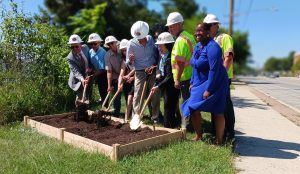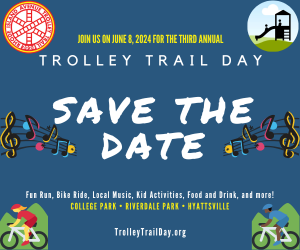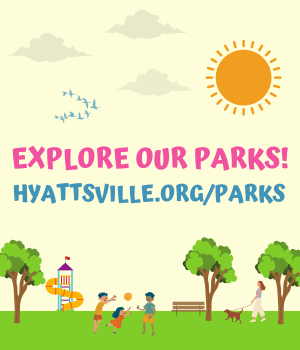By Kit Slack
“We’re finally here!” said Jim Chandler, the City of Hyattsville director of economic and community development. Wearing a gray suit, he spoke to a cluster of onlookers gathered in the hot sun on the morning of June 29 at the spot where the bike trail along the train tracks dead-ends onto Rhode Island Avenue at Farragut Street, a block south of Franklins Restaurant, Brewery and General Store.

Photo credit: Kit Slack
The crowd, mainly government officials and local business owners, was there to put shovels in the dirt to break ground for a half-mile trail extension that will connect the Rhode Island Trolley Trail to the Anacostia Tributary Trail.
That trolley trail gets its name from the Washington D.C. streetcar line that ran in the District in the late 1800s and was extended to Laurel in 1902. The D.C. to Laurel line operated until 1948.
The Trolley Trail Extension’s Extensive History
The new half-mile stretch of trail being built across from the courthouse in Hyattsville this summer will complete a bike trail system running between Fairland Regional Park, outside of Laurel, down along the Anacostia River, all the way to D.C.’s Navy Yard.
At the June 29 groundbreaking, Chandler said that his daughter had asked, as they were on the way to her summer camp that morning, why he was wearing a suit. When he explained he was celebrating a new trail connector that was about to be built, she said, “You’re still doing that?”
Fair enough: Hyattsville councilmembers and staff initiated the project back in 2015, when, according to Chandler, former Mayor Candace Hollingsworth, along with then-councilmembers Kevin Ward and Bart Lawrence made it their priority.
Chandler credited Bob Patten, the trail development manager with the Maryland-National Capital Park and Planning Commission (M-NCPPC), along with Margueritte Smith Clarke, a transportation design engineer with the Maryland State Highway Administration, for their expert dedication to the complicated and difficult work of seeing the project through.
According to Patten, the challenges they faced included the neighboring railway company’s refusal to sell any portion of its right of way to the state. They also had to grapple with exacting standards for state highway construction. In the end, he said, the state highway administration offered unprecedented design flexibility to get the project done.
The new trail, designed for shared use by pedestrians and cyclists, will run along the east side of Route 1 from Farragut Street to Charles Armentrout Drive. Grass buffers and some fences will protect people using the trail, according to Patten, and the road will narrow to one lane northbound in some areas, though it will still have turn lanes and bus pullouts.
According to the state highway administration, the project will cost $6.4 million, and Concrete General, Inc., of Gaithersburg, is the contractor.
Chandler said that some local businesses were initially concerned that car access to their locations might be reduced, but most now strongly support the project. Local business owners Rumi Matsuyama (Maryland Meadworks), Chris Davidson, (Arrow Bicycle) and Nate Groenendyk (Sangfroid Distillery), all attended the event.
Hyattsville Mayor Robert Croslin said the trail extension would be a major improvement and that businesses all along the Route 1 Corridor would benefit.
Maryland State Senator Paul Pinsky spoke of the need, given climate change imperatives, to build infrastructure to make getting out of your car easy, particularly for older people who might have trouble changing their habits. The new trail is designed to be accessible to beginning cyclists.







